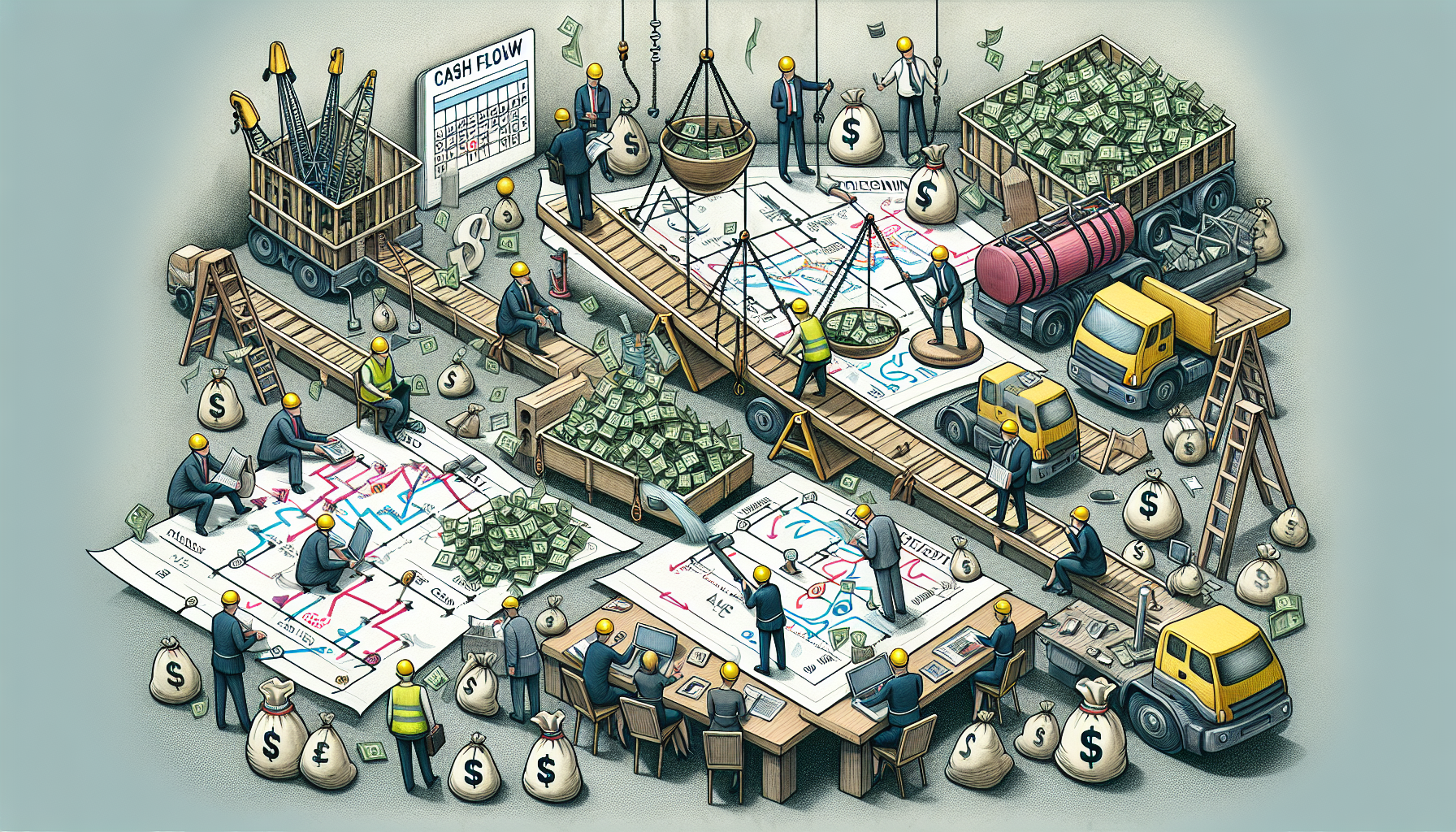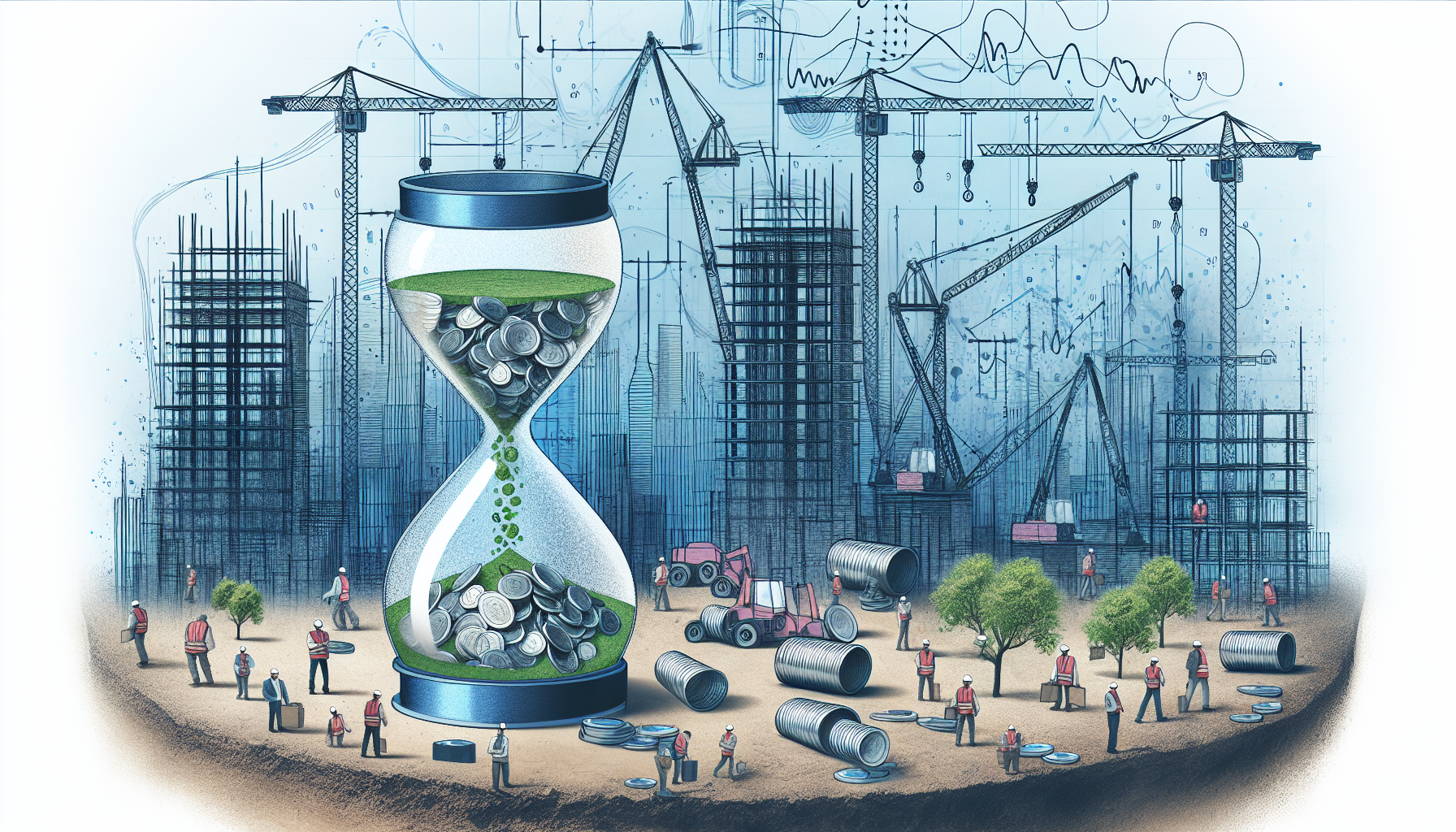Navigating construction cash flow challenges is crucial to keeping your projects on track and maintaining your company’s cash flow. In this article, we’ll tackle the most pressing questions: How do you manage irregular payments and unexpected expenses? What strategies can you implement to ensure a steady cash flow? We’ll guide you through proven tactics for financial stability and show you how to use forecasting to your advantage, so you can focus on building, not just budgeting.
Table of Contents
1. Key Takeaways
Effective cash flow management in construction is crucial for a company’s financial health and includes strategies such as timely billing, managing expenses, and proactive forecasting.
Calculating cash flow involves key formulas such as operating cash flow, net cash flow, and free cash flow to gauge short-term financial health, overall performance, and the availability of funds for future growth.
Leveraging technology, including cash flow forecasting tools and digital payment systems, can significantly improve cash flow management and operational efficiency in the construction industry.
2. Demystifying Construction Cash Flow

Cash flow in construction isn’t just a financial metric; it’s the heartbeat of every project, dictating its pace and vitality. Like the ebb and flow of the tides, money moves in and out of a construction business, shaping the landscape of opportunities and challenges. It’s the power to cover costs, avoid delays, and keep the gears of operation smoothly turning. But what happens when the cash flow falters, when the expected influx of funds becomes a trickle or, worse, dries up? The consequences can be severe, leading to halted projects, strained relationships, and financial instability.
A healthy cash flow in construction not only ensures that bills and employees are paid on time but also fosters a company’s growth and reputation within the industry. It’s about having the financial agility to maneuver through the unpredictable nature of construction projects. The key to demystifying cash flow lies in understanding its mechanics and mastering the strategies to manage it effectively, ensuring a company’s financial health and operational efficiency.
Defining Cash Flow in Construction
When we talk about cash flow in the construction sector, we’re referring to the intricate dance of money as it moves in and out of a business during a given period. It’s the financial lifeblood that pulses through every project, from the initial bid to the final invoice. A cash flow statement lays out this narrative in black and white, chronicling the hard cash’s journey and its utilization over time.
Unlike profit, which signifies the remnant after all bills are paid, cash flow encompasses the total monetary movement, including the ebb of overhead expenses that can make or break a construction company’s financial health. In this context, understanding and managing the construction company’s cash flow is crucial for success.
The Dynamics of Positive and Negative Cash Flow
The life of a construction project can be buoyed by a positive cash flow or sunk by a negative one. Understanding what negative cash flow means is crucial for project managers. When the cash reserves swell with more money coming in than going out, it’s a sign of a healthy project, one that can cover its expenses and even invest in future growth. On the flip side, negative cash flow is a red flag, signaling that the project is spending more than it’s earning, a precarious position that can lead to financial distress and even failure.
The balance between these two states is delicate and can mean the difference between a project’s success and its downfall.
3. Calculating Cash Flow: Key Formulas for Construction Businesses

Calculating cash flow in construction isn’t just about crunching numbers; it’s about painting a financial picture that helps businesses navigate through the complexities of the industry. The basic cash flow formula is straightforward: cash inflows minus cash outflows, with a sprinkle of operating, investing, and financing activities to consider. Yet, there’s more to the story. The working capital formula—current assets minus current liabilities—offers a magnified view of a company’s short-term financial health and its ability to meet immediate obligations.
To drill down further, key formulas like operating cash flow, net cash flow, and free cash flow come into play, each adding depth to the financial analysis. These calculations help construction businesses gauge their ability to fund daily operations, assess overall financial performance, and measure their financial flexibility after covering capital expenditures.
Operating Cash Flow: The Lifeblood of Daily Operations
Operating cash flow is the financial oxygen that sustains the daily activities of a construction company. It’s the net cash generated from the core business operations—everything from paying suppliers to buying materials. Calculating it involves fine-tuning the net income with a dash of non-cash expenses and a touch of changes in working capital.
This formula isn’t just about numbers; it’s about understanding the cash reality behind every project, ensuring that there’s enough in the coffers to maintain stability and keep operations running without a hitch.
Net Cash Flow: Gauging Overall Financial Performance
Net cash flow is the eagle-eye view of a construction company’s financial landscape. It accounts for all forms of cash—those pouring into the business and those draining out—providing a panoramic snapshot of financial well-being. The calculation stitches together cash from operating activities with the threads of investing and financing activities, revealing the true financial fabric of the company.
An accurate net cash flow calculation doesn’t just tell you where you stand; it forecasts where you can go, serving as an essential indicator of a company’s financial performance.
Free Cash Flow: Measuring Financial Flexibility
Free cash flow is the gauge of a construction company’s financial elbow room—the cash that remains after the dust of operating expenses and capital expenditures has settled. It’s calculated by taking the operating cash flow and subtracting the funds used for major asset investments. This metric is a harbinger of a company’s ability to invest in new ventures, reduce debt, or weather financial storms without the need for outside help.
A robust free cash flow signals a company’s financial dexterity, a crucial attribute in the ever-changing construction landscape.
4. Strategies to Improve Cash Flow in Construction

In the world of construction, cash flow is not just about survival; it’s about thriving. The right strategies can turn a financial trickle into a steady stream, ensuring that projects stay on track and businesses grow. One such strategy is fine-tuning the payment schedule, crafting a rhythm of consistent cash inflows. Equally important is managing the billing process effectively, ensuring revenues are not left hanging in the balance. But the financial puzzle isn’t complete without a close eye on project expenses, which, when left unchecked, can lead to cash shortfalls and financial strain.
The cornerstone of a robust cash flow strategy is punctuality—paying stakeholders on time not only keeps the cash cycle moving but also cements a company’s reputation as a reliable partner. From streamlining payment schedules to enhancing billing practices and managing expenses, the goal is to construct a financial framework that holds up even when the winds of uncertainty blow.
Streamlining Payment Schedules for Steady Cash Inflows
The art of streamlining payment schedules is akin to conducting an orchestra—every note must be timed to perfection to create harmony. Clear communication of payment terms to clients is the baton that leads this symphony, setting the tempo for when money exchanges hands.
Tools like Buildertrend empower contractors to send payment requests with the ease of a maestro’s gesture, ensuring a steady cadence of cash inflows. It’s the meticulous choreography of operational efficiency, project timelines, and regular monitoring that ensures the financial performance hits all the right notes.
Effective Billing Practices for Timely Revenue
Crafting a billing process that sings to the tune of timely revenue is a critical measure for improving cash flow. Detailed invoicing, peppered with the convenience of multiple payment options, can expedite the payment process. The digital age ushers in tools like Buildertrend Payments, reducing the average payment receipt time by transforming the way clients settle their bills—from anywhere, at any time.
Such innovations in billing practices don’t just enhance cash flow; they elevate the client experience to an encore-worthy performance.
Managing Project Expenses to Avoid Cash Shortfalls
Staving off cash shortfalls requires a vigilant eye on project expenses, as even the smallest leaks can sink the financial ship. The Profit First method is a financial compass that guides construction companies to prioritize profits and create a sustainable spending strategy. This approach, coupled with training project managers in cash flow management, can turn potential financial icebergs into navigable waters.
Leveraging accounting software for tracking expenses and using cash flow forecasting as a financial radar helps companies to steer clear of the stormy seas of unforeseen costs.’
5. The Role of Cash Flow Forecasting in Construction Planning

Forecasting cash flow in construction is like gazing into a crystal ball, seeking clarity on future financial tides. It’s an essential part of construction planning, providing a map of cash inflows and outflows that help navigate the complexities of the industry. A cash flow forecast is more than a budget; it’s a temporal breakdown of when and how funds will be required, ensuring that every expense is accounted for and every payment is planned.
The forecast serves as a financial compass, guiding companies through the rough waters of economic variables and helping them to anticipate future cash needs. By projecting cash flow, construction businesses can shield themselves from potential cash shortages or surpluses, maintaining a steady financial course towards their destination.
Anticipating Future Cash Needs Through Projections
Cash flow projections are the telescopes that construction businesses use to spot financial horizons. By charting the course of cash inflows and outflows, these projections help companies prepare for future financial needs, acting as a bulwark against unforeseen expenses. Incorporating cash reserves into these forecasts is like stashing a life vest under the deck, ready to be deployed in choppy financial waters.
Strategic financial planning, powered by tools like Cash Flow Frog, ensures that even when the winds of change blow, the construction project remains firmly anchored in financial stability.
Addressing Common Challenges in Cash Flow Forecasting
Forecasting cash flow in construction can be as unpredictable as the weather, with common challenges like unforeseen project disruptions clouding the financial outlook. To ensure the forecast holds water, it’s crucial to factor in external economic factors, regulatory changes, and the unforeseen twists and turns of construction projects.
By accounting for these variables, construction companies can build a robust cash flow forecast that weathers the storm of uncertainty and keeps the construction company’s cash flow positive, ensuring the project remains financially afloat.
6. Monitoring Cash Flow Performance for Sustainable Growth

The vigilant monitoring of cash flow is the sentry that guards the financial gates of a construction company, ensuring the steady flow of funds that are essential for growth and sustainability. Regular check-ups of cash positions can spot trends, warning of financial storms ahead and allowing businesses to batten down the hatches before they’re caught off guard. Organized and precise financial processes enable construction companies to chart a course for informed decisions, steadying the ship for sustainable growth.
The regular review of cash flow is not a task to be taken lightly; it’s a strategic maneuver that can mean the difference between smooth sailing and rough seas. It’s about having the foresight to anticipate when expenses might outpace incomes, and the agility to pivot when necessary, ensuring that the construction project remains on a financially viable trajectory.
Adopting Tools for Real-Time Cash Flow Analysis
In the digital era, real-time cash flow analysis is more accessible than ever, thanks to an array of sophisticated tools and software. These digital solutions act as financial sonar, pinging out signals to detect the current health and future trajectory of a company’s cash flow. By integrating systems like Buildertrend, businesses can gain a panoramic view of their finances, allowing them to react swiftly to any changes in their financial landscape.
The resulting insights can not only prevent a cash crunch but also unlock opportunities for strategic investments and improvements.
Implementing Cash Flow Management Strategies
To navigate the financial currents of the construction industry, effective cash flow management strategies are as vital as a captain’s knowledge of the seas. Monitoring monthly income against expenses and acting swiftly when the scales tip towards the red can keep a company’s finances buoyant. Establishing a routine for reviewing cash positions yields a treasure trove of insights that inform data-driven decisions and strategic course corrections.
Moreover, creating incentives for project managers based on cash flow performance can encourage a culture of financial responsibility and foresight throughout the organization.
7. Navigating Cash Flow Issues in the Construction Industry
Cash flow issues in construction are like hidden reefs that can unexpectedly damage the hull of a business. Common problems include the challenge of managing upfront expenses, the pitfalls of inaccurate budgeting, and the risk of falling into negative cash flow. While these issues may seem daunting, they are not insurmountable. Strategic use of financial tools like lines of credit, and factoring can provide the necessary lifeline to keep businesses afloat during cash flow droughts. Coupled with other tactics such as cost spreading and prompt change order processing, construction companies can navigate through these financial straits with confidence.
Understanding the importance of cash flow forecasting is akin to having a reliable compass; it allows contractors to chart a course through potential cash shortages or surpluses, ensuring they are prepared for future financial tides. By managing project timelines and monitoring budgets closely, construction businesses can avoid the dangers of running aground financially and keep their projects sailing smoothly towards completion.
Recognizing Early Signs of Cash Flow Problems
The ability to recognize the early signs of cash flow problems is a vital navigational skill for any construction company. Warning signs such as slow payments, material shortages, and spiraling overhead expenses can serve as a signal flare, indicating that trouble may be on the horizon. Delayed payments, in particular, can create ripples that disrupt the financial flow and project timelines, underscoring the need for proactive cash flow management.
By keeping a watchful eye on the inflows and outflows of cash, contractors can detect these risks early and take the helm to steer their company away from financial distress.
Resolving Cash Flow Challenges
When cash flow challenges arise, resolving them requires a combination of strategic maneuvering and financial acumen. Reducing expenses, seeking alternative funding sources, and implementing strategies like cost spreading can turn the tide on cash flow conundrums.
Additionally, using credit as a floating device enables construction companies to navigate through periods of negative cash flow until the calm seas of positive cash flow are reached once again. By employing these tactics, businesses can right their ship and sail towards financial stability and success.
8. Harnessing Technology to Streamline Cash Flow in Construction
In the quest for financial efficiency, technology serves as the master tool for streamlining cash flow in construction. With innovative software solutions at their disposal, construction companies can gain comprehensive insights into their cash flow needs, making it easier to manage and forecast financial requirements. From project management to accounting, technology integrates various aspects of business operations, providing a unified command center from which to oversee cash flow.
By embracing these digital advancements, construction firms can fortify their financial foundations, ensuring they are well-equipped to handle the dynamic demands of the industry.
Leveraging Software for Efficient Cash Flow Forecasting
Software like Cash Flow Frog and Planyard acts as the navigator in the complex journey of cash flow management, providing construction businesses with the tools to chart a clear financial course. These platforms offer features such as project-specific projections and actual financial comparisons, enabling businesses to anticipate future cash positions with accuracy.
The ability to track and manage budgets and expenses in real-time ensures that construction companies can maintain a firm grip on their financial rudder, steering clear of any potential cash flow hazards.
Utilizing Digital Payment Systems for Faster Transactions
The adoption of digital payment systems in construction is akin to installing high-speed propellers on a vessel, accelerating financial transactions, and streamlining the flow of cash. By offering a variety of electronic payment options, construction companies can ensure faster payment processes, which in turn, enhances cash flow and reduces the drag of delayed payments.
This technological leap forward not only boosts the company’s bottom line but also modernizes the client experience, making it more convenient and efficient for all parties involved.
9. Construction cash flow template
Every construction project manager needs to manage project cash flow. Here you can download construction cash flow templates:
Summary
Navigating the financial waters of the construction industry requires mastery over cash flow, which is as vital to project success as the foundation is to a building. From understanding the basic dynamics of cash flow to leveraging technology for streamlined management, the strategies covered in this blog post provide a robust framework for any construction business looking to solidify its financial health. By adopting effective billing practices, managing project expenses, and using forecasts to anticipate financial needs, companies can ensure they’re not only surviving but thriving in the competitive landscape of construction.
As we’ve explored, the importance of cash flow cannot be overstated—it’s the lifeline that keeps projects moving and businesses growing. With the tools and insights provided, construction companies are well-equipped to improve their cash flow, overcome common challenges, and navigate the complexities of the industry with confidence. Embrace these strategies, and watch your business reach new heights, one well-funded project at a time.
10. Frequently Asked Questions
What is cash flow in construction?
Cash flow in construction is the financial undercurrent that determines the viability and success of a project. It represents the movement of funds in and out of a business, influencing the company’s ability to handle project-related expenses and maintain a steady pace of growth. From the mobilization of resources to the final touches of a build, cash flow is the economic engine that drives the construction process, ensuring that every stage is well-funded and on schedule.
Mastering the flow of cash is therefore not just a financial task; it’s a strategic imperative that underpins the entire construction operation.
How to manage cash flow in construction?
Managing cash flow in construction is a balancing act that requires precision and foresight. To steer a company towards financial stability, it’s crucial to maintain a laser focus on timely billing, expense management, and proactive cash flow analysis. With strategies such as leveraging forecasts, negotiating favorable vendor terms, and utilizing accounting software, companies can ensure a steady stream of cash inflows and guard against financial pitfalls.
By adopting a holistic approach to cash flow management, construction businesses can cement their financial footing, paving the way for sustained growth and operational excellence.
How to construct a cash flow statement in construction?
Constructing a cash flow statement in construction is a meticulous process that captures the essence of a company’s financial movements. This statement sheds light on past transactions, providing a historical record of liquidity and financial strength. It follows a rhythmic pattern that aligns with the life cycle of a construction project, from the initial stages to post-construction, accounting for the cyclical nature of cash flow within each phase.
By combining the total project budget with actual expenditures and projected costs, and mapping them against the project schedule, construction companies can craft a cash flow statement that serves as a financial blueprint for success.
What is a cash flow forecast in construction?
A cash flow forecast in construction is a financial compass that guides project owners and general contractors through the fiscal landscape of a build. It projects the anticipated cash expenditures over a set period, providing a roadmap for when and how much money will be spent. This foresight is critical for financial planning, allowing construction businesses to mitigate financial risks and ensure sufficient fund availability throughout the project lifecycle.
By accurately forecasting cash flow, companies can:
Maintain a steady course
Avoid the pitfalls of underestimating or overestimating financial needs
Prevent project delays
Avoid unnecessary costs
How to improve cash flow in construction?
Improving cash flow in construction requires a blend of strategic ingenuity and financial discipline. Here are some tactics that can streamline the cash cycle and enhance liquidity:
Integrate clear payment terms into contracts
Offer early payment discounts
Impose penalties for late payments
Systematize payment schedules
Diversify payment methods
Negotiate with vendors
By implementing these strategies, you can create a more robust cash flow management system.
By fortifying their cash flow, construction companies can ensure they have enough funds to cover expenses and capitalize on growth opportunities. Here are some strategies to consider:
Bill promptly to ensure timely payment from clients.
Acquire lines of credit for financial buffering during slow periods.
Engage in long-term financing for significant investments.
Implementing these strategies can help construction companies maintain a healthy cash flow and thrive in the industry.
Importance of cash flow in construction
Cash flow is the financial cornerstone of the construction industry, supporting everything from project initiation to successful completion. Effective cash flow management ensures companies can:
Meet their obligations, from covering expenses to paying workers punctually, thereby avoiding delays and maintaining project momentum
Serve as a financial shield against risks such as delayed payments and unexpected costs
Navigate the choppy waters of the construction sector with confidence
By prioritizing cash flow, construction companies not only protect their financial health but also lay the groundwork for future success and industry leadership.
The most common cash flow problems in construction
The construction industry is no stranger to cash flow problems, which can arise from a variety of sources such as:
Early bill payments depleting cash reserves
The complexities of joint ventures affecting payment timing
The absence of advance payments for projects, which can place a significant financial burden on construction firms
A lack of a clear credit policy, which may lead to suboptimal credit decisions.
Additionally, poor management of change orders can result in underpayment, further exacerbating cash flow issues. Understanding these common problems is the first step towards implementing effective solutions to maintain financial stability.
How do construction companies calculate cash flow?
Construction companies calculate cash flow by using formulas that consider operating income, non-cash expenses, and changes in working capital to measure operating, net, and free cash flow. This helps them understand the financial health of their business and plan for future expenditures.
How can technology help improve cash flow in construction?
Incorporating construction management software and digital payment systems allows for real-time analysis, streamlined billing and payment processes, and efficient cash flow forecasting, which can significantly improve cash flow in construction.
About the Author

Taavi Kaiv
Taavi Kaiv is a construction specialist with over ten years of experience in the construction industry. Taavi is an accomplished construction project manager with many successful projects that have been completed under his guidance. Taavi holds a master’s degree in construction management from the Tallinn University of Technology. View profile






